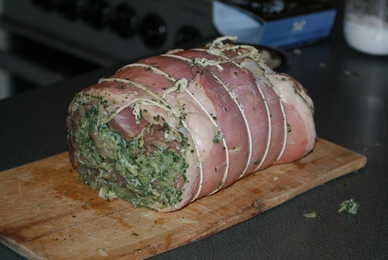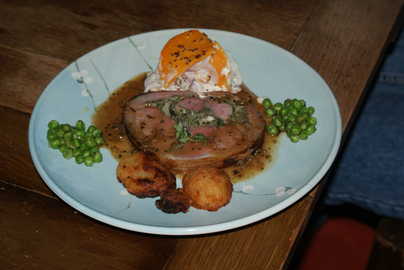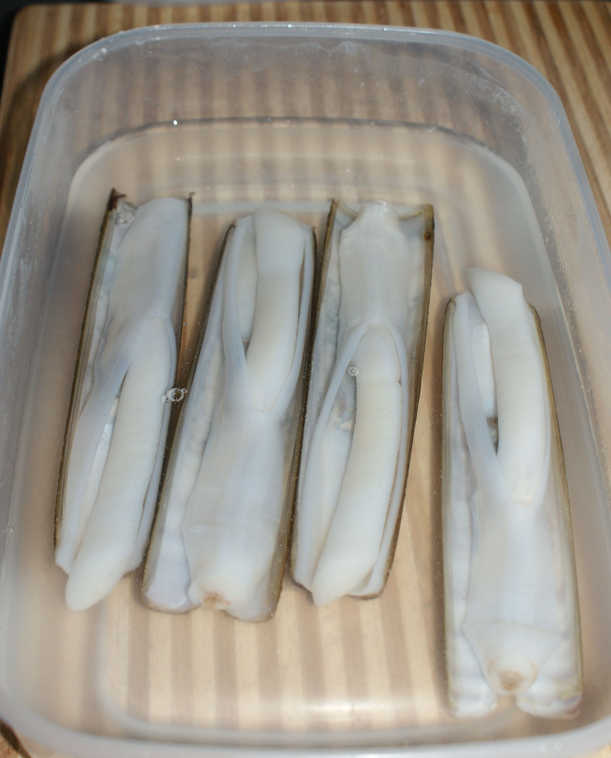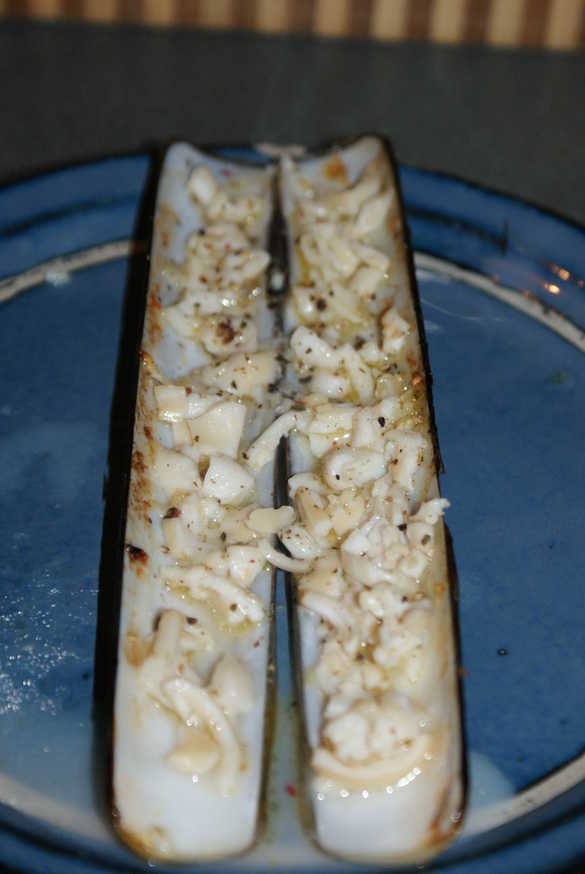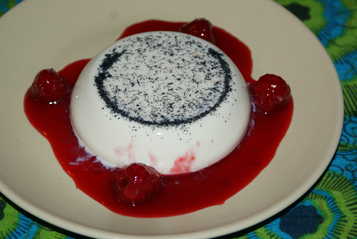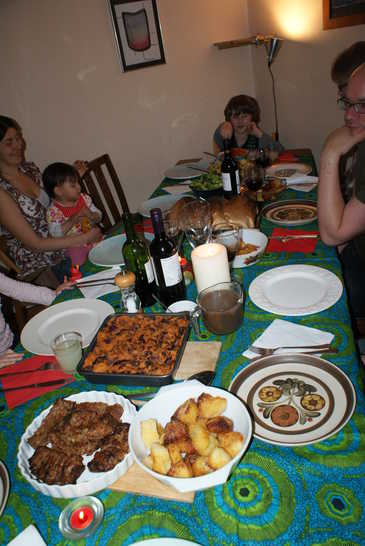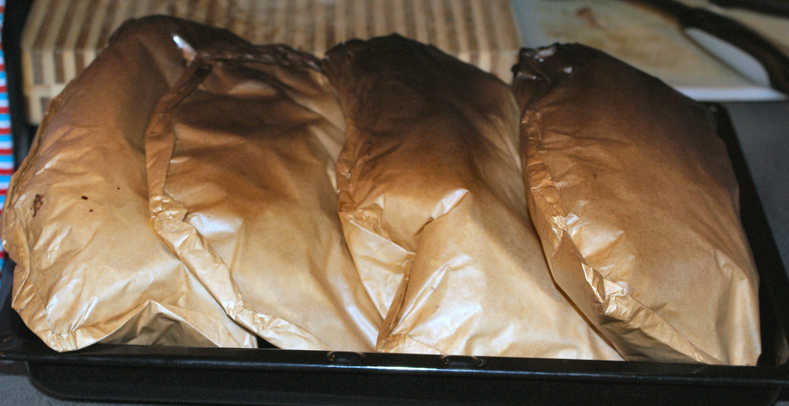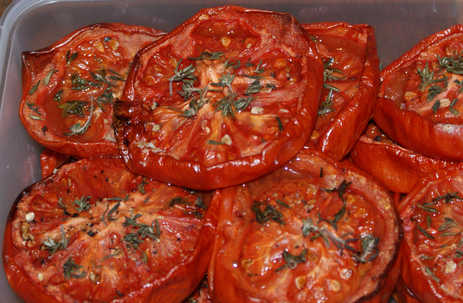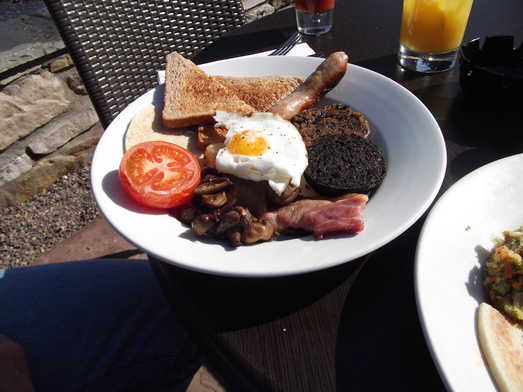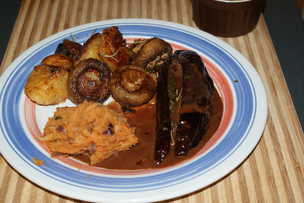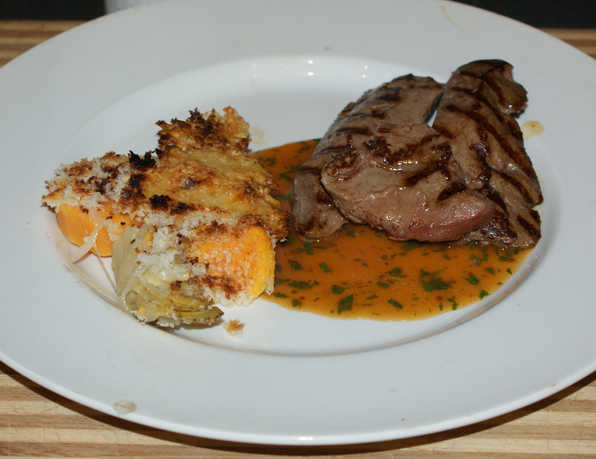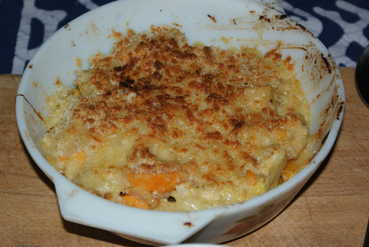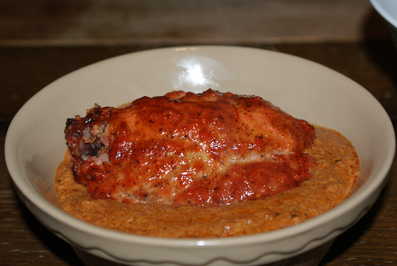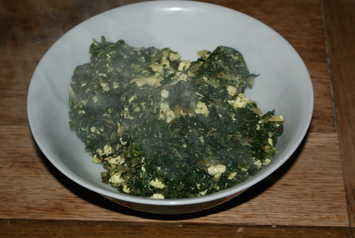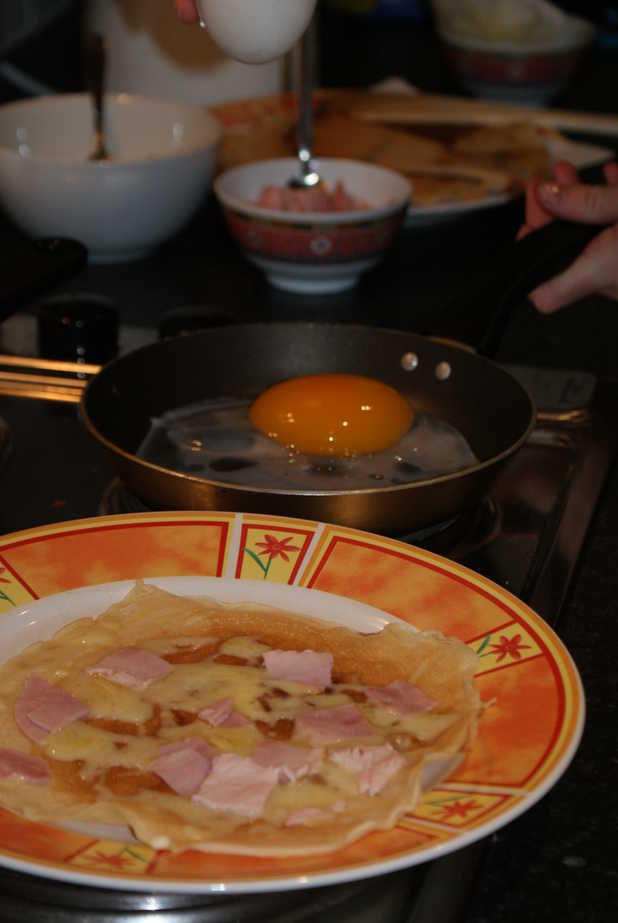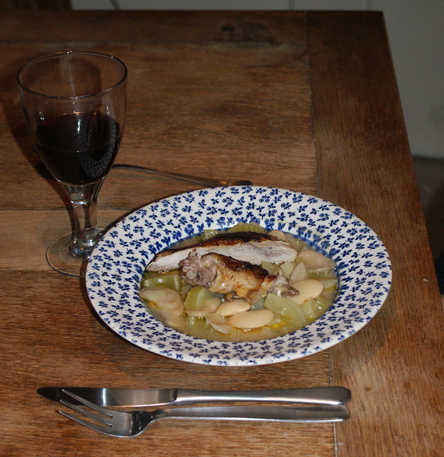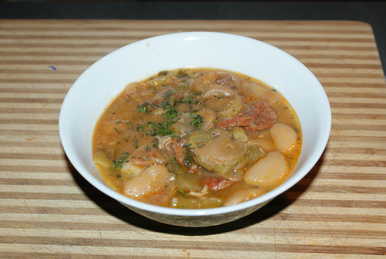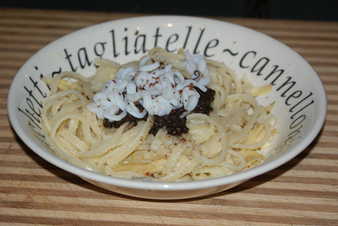
Mustards and Oysters

Astonish your friends. Impress your guests. Stuff their lamb with oysters!
Though judging from the leftovers on their plates, my guests were not so much impressed as horrified.
Browsing, as you do, the Guardian's back-catalogue of recipes I came across an interesting-looking idea for stuffing a saddle of lamb with oysters. Then as I was passing the ever-excellent butcher George Bower in Stockbridge I happened to notice their sign warning of the imminent sellout of their stock of spring lambs, so I thought I'd better get my hunk of sheep while the going was good. Remembering the oyster recipe, and observing the fishmongers opposite I decided to get myself a bunch of oysters and a saddle of lamb to stuff them with. A thirty-pound-sterling saddle as it turned out. These small sheep are getting bloody expensive - I wonder if it wouldn't be easier just to rear my own and slaughter them in the bath?
I bought myself ten fresh oysters in the vain hope they would yield the 8 oz of oyster meat called for in the recipe, and a pot of white crab-meat. In fact I had misread the recipe and thought it required both oysters and crab-meat, but it actually suggests smoked oysters and crab-meat as an alternative to the plain oysters, though in my defence it's not very clearly written. When my oysters yielded a disappointingly meagre 4 oz of flesh I also added a couple of ounces of the crab-meat and a half-dozen anchovies. But in the end there was rather more stuffing than my saddle could hold (and it was very nearly the required 3lb after boning and trimming as instructed), despite my best ramming efforts. The general opinion was that it really had quite enough oyster, I don't think the crab-meat added anything of great value but I quite liked the touch of anchovy saltiness, so I've amended the recipe accordingly.
According to the blurb at the top of the recipe, traditionally there were clear combinations of fish and meat - anchovies with beef, oysters with mutton, crab with lamb. Certainly there are plenty of eighteenth century recipes for shoulder of mutton with oysters, though I'm not so sure about the lamb and crab. The anchovies seemed to work for me though.
Anyway, since you can hardly find mutton these days this modern recipe calls for a saddle of lamb instead, and allows for (cheaper) frozen oysters which must be a particularly American thing - they don't seem to exist much over here.
The recipe also has something do with mustard, which encouraged me to a vaguely mustard-themed menu, with a herby mustard bread, roast potatoes with a floury mustard crust, and a mustardy butternut squash gratin. I stopped short at a mustard desert though - coward that I am. Perhaps I've been chastened by my experiments with crab ice cream?
On the whole a pretty tasty meal (well, I liked the lamb, the peas were oddly well-received and the panna cotta was as popular as ever) - apologies to my guests Grecky for the late invite, the lamb purchase was a bit spur-of-the-moment!
menu
Starter
Herb and Mustard Bread
Strathdon Blue and Walnut Salad
Main Course
Saddle of Lamb Stuffed with Oysters in a Mustard and Port Glaze
Butternut Squash and Mustard Gratin
Dessert
Liquorice Panna Cotta with Raspberry Syrup
Herb and Mustard Bread
Strathdon Blue and Walnut Salad
Handy filled chicory leaves Hors D'oeuvre.
Main Course
Saddle of Lamb Stuffed with Oysters in a Mustard and Port Glaze
Butternut Squash and Mustard Gratin
A tasty side dish. When properly cooked.
Braised Green Peas
Well received and tasty peas.
Mustard Roast PotatoesDessert
Liquorice Panna Cotta with Raspberry Syrup
My joint was about perfectly medium cooked (just slightly pink) after 1½ hours cooking - I took it out when the internal temperature reached 125° and it finally peaked at 130° while resting. Myself I would have gone for slightly more rare, and pulled it out at 110°F, but the meat was beautifully tender.
Unfortunately, the skin was a bit like hard rubber - it completely failed to crisp up: I really should have cranked up the temperature to start with for 15 minutes or so.
The gravy was a bit weird - I thought it might have taken a bit more colour and thickened slightly, but it remained somewhat on the thin side and a little grey and anaemic looking. Still reasonably tasty though. I did add some water to the roasting tin under the racked lamb, and perhaps I put in too much which prevented any of the juices from crisping up in the tin to give some colour.
I've learned from bitter (!) experience with the Christmas Goose that if you want to deglaze the roasting tin to make gravy, it's a good idea to add a little water (or juice/wine/vinegar/etc) to the roasting tin just at the start so that the first meat drippings don't stick and burn to a horrible layer of charcoal.
If you're sitting the meat directly in the roasting tin you can just make a protective bed of bones, mirepoix or sliced onion.
Unfortunately if you add too much water the drippings will never caramelise in the tin so finding some kind of middle ground would be ideal - this rolled joint did seem to leak quite a lot of juices.
I'd definitely make this again. But better :)
Comments (0)
Oot, Damned Spoot!

Razor clams. Damn those razor clams. I keep trying with them - I mean surely there must be something to them - they're ever so popular in all the fancy restaurants. Though on the other hand they are as cheap as dirt. So maybe the fishmongers know something fancy restaurateurs don't?
It so happened that I had a bunch of razor clams (or spoots) that I bought to try using instead of squid in my lacy squid. Incidentally, razor clams don't go lacy. In fact if you cut them up thinly and blanch them they just turn into rubbery bands. What (very) little flavour they ever had seems to be just leached away. So no blanching.
Your first problem when it comes to making something edible out of a razor clam is the grit. They love grit. They're just chock full of grit. Or sand. Or something equally gritty. So you need to rinse them really thoroughly in running water. Preferably overnight. But don't leave them covered in water - they'll just drown.
Your second problem is cleaning them - they're pretty ugly, complicated beasts that need various hard, foul or yes gritty bits removing. Some recipes just steam them like mussels, then slice up the flesh, but others clean and prepare them before cooking. Maybe if you can do this well enough you won't need to leave them all night in running water in your bath. Maybe.
You can persuade them to open up by briefly blanching them in boiling water, or pouring the water over them. (Or by drowning them!)
Cool them off quickly afterwards, though, or they'll turn rubbery.
Once the shells are open the body will easily pull out. You can hunt around the interwebs for videos and pictures of how to clean them (if you can work out what's going on). Mostly it's the used-condom-like digger which produces the best of the flesh. All I got from the rest of the body was something resembling a string bag, but I suppose that might get better with practice.
Your third problem is cooking them in some way that doesn't turn them to rubber. I'm sad to say I haven't found that method yet.
I did try grilling them in garlic butter on their shells, which wasn't too awful. They still turn a bit rubbery, don't have a huge amount of flavour, but you do get a lot of juice so it's nice to have a bit of bread to soak it up - at least the garlic butter tastes good!
Razor Clams with Garlic Butter
starter fish
Yeah, they're still rubbery. They're rubbery if you eat them raw. They're rubbery if you blanch them.
They're rubbery if you fry them. Accept it - they're just rubbery.
Use 3-4 spoots per person
Ingredients
- razor clams
- garlic
- butter
- slices of bread or ciabatta
Thoroughly rinse the razor clams.
Briefly immerse them in boiling water or pour boiling water over them until they open, then plunge into cold water.
Gently pull the bodies free of their shells, trim and clean the edible parts: Cut off the black tip of the siphon neck. Using scissors, cut the clam lengthways up the zipper from the digger along the siphon neck, then cut there again to get the lower chamber of the neck.
Cut around the slippery tan gills, mouth and digger to separate them from the rest of the white body.
Squeeze the digger to reveal the dark stomach then snip around it and the gills and remove them. Remove any crystalline rod or style used by the clam as a digestive enzyme.
Cut the digger open lengthways and clean out any sandy vein.
Rinse the white meat clean of anything dark or brown.
Cut the clam meat up into small pieces, clean a shell per person, slice the bread, preheat your grill.
Press the garlic, mash with butter, mix with the chopped clams and use to fill the cleaned shells. Grind a little pepper over the top.
Place each pair of half-shells on top of a slice of bread on a folded piece of tin foil (to hold the juices).
Grill briefly until they begin to colour, and serve on the bread with a lemon wedge on the side.
Gently pull the bodies free of their shells, trim and clean the edible parts: Cut off the black tip of the siphon neck. Using scissors, cut the clam lengthways up the zipper from the digger along the siphon neck, then cut there again to get the lower chamber of the neck.
Cut around the slippery tan gills, mouth and digger to separate them from the rest of the white body.
Squeeze the digger to reveal the dark stomach then snip around it and the gills and remove them. Remove any crystalline rod or style used by the clam as a digestive enzyme.
Cut the digger open lengthways and clean out any sandy vein.
Rinse the white meat clean of anything dark or brown.
Cut the clam meat up into small pieces, clean a shell per person, slice the bread, preheat your grill.
Press the garlic, mash with butter, mix with the chopped clams and use to fill the cleaned shells. Grind a little pepper over the top.
Place each pair of half-shells on top of a slice of bread on a folded piece of tin foil (to hold the juices).
Grill briefly until they begin to colour, and serve on the bread with a lemon wedge on the side.
I guess you could add minced shallots, tomatoes, herbs, breadcrumbs, spices (say, some crushed fennel seeds) or even prepare them as for
Coquille Saint-Jacques, but I don't believe you'll be getting any silk purses out of these little piggies.
Unseasonably Lacy Squid

Finally with the lacy squid!
I first encountered the squid de dentelle at Oloroso about a year ago. It was just a side-note in Mum's main course fish dish, but I was impressed by the way the thin squiddy strings had twisted themselves up like fishy curly fries, and how tender they were. I've been completely unable to find anything more about the idea since, despite some effort pacé Google. So I decided to use up some handy complementary leftovers and have a bash at making a squiddy pasta dish every bit as lacy as theirs.
Trust me to want to do it outside squid season though. Which, since you ask, is September - November (or June - January at the outside). I bought some razor clams from my excellent fishmonger to use as a substitute, but caved in completely at the sight of the freshly unfrozen squid at the fish counter of my local Fucking Supermarket™
Since I wasn't sure how to get that Oloroso lacy effect in my squid I prepared a number of different samples, intending to flash-fry them all and see how they turned out.
Firstly I sliced open two squid bodies along the seam and laid them out flat. One sheet I lightly scored on the soft (non-skin) side about 1cm apart, then sliced them both up lengthways in various thicknesses between the thinnest I could manage and about 3mm ribbons.
I also separated out the tentacles.
- Sample 1: Separated tentacles
- Sample 2: Squid tube, opened out, thinly sliced
- Sample 2a: Squid tube, opened out, 3mm slices
- Sample 3: Squid tube, opened out, lightly scored, thinly sliced
- Sample 3a: Squid tube, opened out, lightly scored, 3mm slices
I had my frying pan all prepped and ready to go, when it occurred to me to try blanching one of the sliced samples first and see if that helped, and was astonished to see them wind themselves up into lacy albino ribbons just like at Oloroso. Still beautifully tender too. So I just blanched the lot (slightly wary of overcooking them), all the samples seem to curl up pretty much the same way except for the tentacles.
So much for all my scientific endeavour.
The rest of my Lacy Squid Linguine and Panna Cotta with Raspberry Syrup came about from the collection of oiled artichoke hearts, tapenade and vanilla flavouring I had left over from previous meals.
I wonder if this might also be an occasion to bring out the squid ink pasta, but how to avoid the black-on-black crime of that tapenade?
Lacy Squid Linguine with Artichoke Hearts and Tapenade
main fish pasta
Thin pasta, thinly sliced artichoke hearts and thin ribbons of squid.
Well, the shapes all match, and the tapenade brings them all together nicely.
Serves 2
Ingredients
- 2 medium squid
- 2 servings linguine
- olive oil
- 4 teaspoons tapenade
- 1 globe artichoke (or ½ jar artichoke hearts in oil)
- ½ teaspoon red peppercorns
- parmesan
Prepare your artichoke hearts: trim away most of the leaves, cut into eighths, remove any hairs, then blanch for 4 minutes until tender.
Or just open the jar.
Slice the hearts (and through any leaves still attached) into quite thin segments, toss in olive oil and set aside.
Clean the squid: pull out the innards and quill, remove any outer membrane from the tubes and rinse them out well. Cut away the individual tentacles if you like - I thought they added a nice contrast. Cut open the tube along its seam and lay it flat with the soft inner side up. Pull away any membrane, then slice lengthways reasonably thinly (1-2mm). Set the slices and tentacles aside.
Grate the parmesan.
Grind up the red peppercorns.
Put the squid strings into a sieve. Cook your linguine and when it is just about ready turn up the heat, plunge the squid into the water and shake them around until the water returns to the boil they should curl up nicely at this point, then remove the squid. Drain the pasta, toss with a little olive oil, some parmesan some of the ground red peppercorns? and the artichoke hearts.
To serve, heap pasta into serving bowls, heap on a spoonful or two of the tapenade, and top with the lacy squid.
Sprinkle on the ground red peppercorns.
Or just open the jar.
Slice the hearts (and through any leaves still attached) into quite thin segments, toss in olive oil and set aside.
Clean the squid: pull out the innards and quill, remove any outer membrane from the tubes and rinse them out well. Cut away the individual tentacles if you like - I thought they added a nice contrast. Cut open the tube along its seam and lay it flat with the soft inner side up. Pull away any membrane, then slice lengthways reasonably thinly (1-2mm). Set the slices and tentacles aside.
Grate the parmesan.
Grind up the red peppercorns.
Put the squid strings into a sieve. Cook your linguine and when it is just about ready turn up the heat, plunge the squid into the water and shake them around until the water returns to the boil they should curl up nicely at this point, then remove the squid. Drain the pasta, toss with a little olive oil, some parmesan some of the ground red peppercorns? and the artichoke hearts.
To serve, heap pasta into serving bowls, heap on a spoonful or two of the tapenade, and top with the lacy squid.
Sprinkle on the ground red peppercorns.
Excellent. Very pleased with that!
You need to get the balance right here though - it's easy to overload the tapenade or the parmesan.
You need to get the balance right here though - it's easy to overload the tapenade or the parmesan.
Vanilla Panna Cotta with Raspberry Syrup
dessert
I made this using some vanilla-infused vodka that I had left left over from
some fishy parcels.
Although the flavour was fine I did find the vast number of vanilla seeds made the panna cottas look a bit pox-ridden.
They were still popular though.
I think next time I make this I'll try liquorice flavour instead of vanilla, which should go nicely with the raspberry syrup.
They were still popular though.
I think next time I make this I'll try liquorice flavour instead of vanilla, which should go nicely with the raspberry syrup.
Serves 4
Ingredients
For the panna cotta:- 2½ x 2g gelatine leaves
- 250ml/9 fl oz milk
- 250ml/9 fl oz double cream
- 1 vanilla pod, split lengthways, seeds scraped out
- 25g/1oz sugar
For the syrup:- 50g/2 oz sugar
- 50ml/2 fl oz water
- glass Chambord or a cherry liqueur
- 250g/9 oz raspberries or cherries
To serve:- 4 sprigs fresh mint
- icing sugar, for dusting
For the panna cotta: soak the gelatine leaves in a little cold water until soft.
Place the milk, cream, vanilla pod and seeds and sugar into a pan and bring to a simmer. Remove the vanilla pod and discard.
Squeeze the water out of the gelatine leaves, then add to the pan and take off the heat. Stir until the gelatine has dissolved.
Divide the mixture among four 100ml ramekins, cover with cling-film and leave to cool. The surface gets a bit leathery if you don't cover it. You can also pour a little of the syrup on top instead. It helps if you fill the ramekins right to the top - also with turning out. Place into the fridge for at least an hour, until set.
For the syrup: place the sugar, water and liqueur into a pan and bring to the boil. Reduce the heat and simmer until the sugar has dissolved.
Take the pan off the heat and add two-thirds of the raspberries. Cook until the fruit disintegrates then pass through a sieve to strain out the seeds. Stir in the remaining fruit.
To serve: warm each ramekin in hot water for about 5 seconds (only!) to free it then turn the panna cotta out onto a serving plate. Spoon around the warm sauce feel free to refresh it with a little more liqueur and garnish with a sprig of mint.
Dust with icing sugar.
Squeeze the water out of the gelatine leaves, then add to the pan and take off the heat. Stir until the gelatine has dissolved.
Divide the mixture among four 100ml ramekins, cover with cling-film and leave to cool. The surface gets a bit leathery if you don't cover it. You can also pour a little of the syrup on top instead. It helps if you fill the ramekins right to the top - also with turning out. Place into the fridge for at least an hour, until set.
For the syrup: place the sugar, water and liqueur into a pan and bring to the boil. Reduce the heat and simmer until the sugar has dissolved.
Take the pan off the heat and add two-thirds of the raspberries. Cook until the fruit disintegrates then pass through a sieve to strain out the seeds. Stir in the remaining fruit.
To serve: warm each ramekin in hot water for about 5 seconds (only!) to free it then turn the panna cotta out onto a serving plate. Spoon around the warm sauce feel free to refresh it with a little more liqueur and garnish with a sprig of mint.
Dust with icing sugar.
Hmmm, creamy.
I like my panna cotta a bit on the wobbly side, so add the extra half gelatine sheet if you like a firmer set. My gelatine sheets weighed 18g for 10, so a bit lighter than 2g each. Swiz!
I like my panna cotta a bit on the wobbly side, so add the extra half gelatine sheet if you like a firmer set. My gelatine sheets weighed 18g for 10, so a bit lighter than 2g each. Swiz!
Aline's Last Supper

Time for my cute landlady Aline to ship out to Borneo where she will become intimately familiar with the tops of ancient rainforest and Muslim full-body coverings. Not necessarily in that order. And hopefully not simultaneously.
She celebrated with a roast dinner to say goodbye to all her Edinburgh friends, which oddly, consisted mostly of boiled vegetables.
The food, not her friends. Her friends are quite nice when you get to know them! But then we do have quite a small oven.
We managed a sit-down meal for 11 people only an hour or so behind schedule, though we did have to hijack the spare bedroom for an impromptu dining room. Much to the distress of my new flatmate, who moved in later that evening. Or tried to.
Welcome Carmen!
Enough of Aline's friends are piscatorians to justify trying out my idea for an en Papillote fish with vanilla flavouring which I was very happy with, and seemed generally well received. Pity my photo of the parcel's contents drowning in a pool of watery-looking juices didn't do it justice!
It's a pretty easy dish to make because you can get most of the prep work out of the way well ahead of time - I roasted the tomatoes and made up the tapenade, and the vanilla vodka infusion over a couple of evenings last week. I did have to spend about half an hour de-boning the Dory earlier in the day, which was a lot more trouble than I wanted. Damn those Dory bones - they really hang in there. I think it's worth putting in maximum effort though - I just hate finding a mouthful of bones - it spoils the whole dish.
I cut out the greaseproof paper and foil sheets ahead of time, but I didn't want to make up the packets until just before cooking - I wasn't sure what the (presumably) slightly acidic tomato juices might do to the tin foil if they were sitting around for any length of time.
I was given responsibility for the roast potatoes (successfully crunchy) and the roast parsnips (not-so-crunchy), and Aline took charge of everything else. See here for details She did a terrific job of timing it all, despite being hindered by the oven going out two or three times. Not sure what's going on there!
Aline also wanted a special mention for her hard-working and long-suffering! KP Des who did an excellent job of peeling and chopping all the veg and nuts - thanks Des!
Our dodgy oven might explain the slightly disappointing nut roast Yes - nut roast! Apparently vegetarians really do eat the stuff! which was a bit soggy, and then a bit burnt from its rescue grilling. Either it was the oven thing, or it was including rather too much vegetables, or it was mixing it up too early and leaving it sitting around for too long.
Pity, because it was actually quite tasty. For a nut roast :)
Happy Trails Aline!
menu
The Roasts
John Dory en Papillote with Vanilla Vodka
Nut Roast
Crunchy Roast Potatoes
Not So Crunchy Roast Parsnips
Matchstick carrots with thyme and honey
Vegetarian Gravy
John Dory en Papillote with Vanilla Vodka
Nut Roast
Crunchy Roast Potatoes
Not So Crunchy Roast Parsnips
Roast in a lot of (peanut) oil in a bread tin due to lack of space - they were tasty but greasy.
And not much crunchy.
Sweet and Spicy MashMatchstick carrots with thyme and honey
Cut up your carrots, boil them, then dress with thyme, honey and olive oil (or butter - if you aren't intolerant).
Season.
Serve.
Boiled New potatoes with mintSeason.
Serve.
Boil your new potatoes, drain, season with salt and torn mint leaves and more olive oil.
Steamed broccoliVegetarian Gravy
John Dory en Papillote with Vanilla Vodka
main fish
John Dory fillets en papillote with roast tomatoes and vanilla infused vodka sauce
I decided to have a go at developing a Rick Stein recipe
by replacing the basil flavouring with vanilla, and thought I might use vodka to extract more essence from the vanilla pods.
I suppose you might be able to use vodka that you've just had steeping with vanilla pods for a while, rather than cooking it as I did,
but I'm not sure you'd get the same intensity of vanilla flavour.
I was slightly worried that the vanilla might be too overpowering, but that didn't seem to be a problem, despite turning the sauce quite dark with the extracted vanilla oils.
I was slightly worried that the vanilla might be too overpowering, but that didn't seem to be a problem, despite turning the sauce quite dark with the extracted vanilla oils.
Serves 4
Ingredients
- olive oil, for brushing
- 4 x 175-225g (6-8 oz) pieces of thick John Dory fillets, carefully de-boned (skin on is fine)
- 4 tablespoons Tapenade
- salt and freshly ground black pepper
For the vodka infusion:- ¼ cup vodka or so 6 tablespoons ish
- 4 vanilla pods, slit and cut in quarters
- ½ cup stock (or so) seafood or vegetable. Not beef!
For the oven-roasted tomatoes:- 12 fat juicy ripe tomatoes - about 1½ lb (750g)
- ½ teaspoon Maldon sea-salt flakes
- 1 teaspoon thyme leaves
For the oven-roasted tomatoes:
Pre-heat the oven to 240°C/475°F/Gas Mark 9.
Cut the tomatoes in half and place them cut-side up in a lightly oiled shallow roasting tin. Sprinkle over the sea-salt flakes, thyme leaves and some pepper and roast for 15 minutes. Lower the oven temperature to 150°C/300°F/Gas Mark 2 and roast them for a further 1½-2 hours until shrivelled to about half their original size and concentrated in flavour.
Remove and leave to cool.
These will keep for several days covered in the fridge.
Make the tapenade.
For the vodka infusion:
When the pods seem softened and and a delicious aroma of vanilla has been released (and the sauce has started to darken), remove from the heat, add another good dose of vodka, cover tightly with cling film and leave to infuse overnight in the fridge.
You should end up with about 6 tablespoons or so.
Raise the oven temperature to 240°C/475°F/Gas Mark 9 again.
Prepare the paper and foil parcels:
Cut out four 38cm (15 inch) squares of greaseproof paper and foil. Put the foil squares on top of the paper ones and brush the centres with olive oil. Season the pieces of fish on both sides with salt and pepper. Scrape the skin from 3 roasted tomato halves and possibly cut them up a little too? and put them slightly off-centre on each one, top with the pieces of seasoned fish, drizzle over a tablespoon or two of the vodka infusion.
Bring the other side of the square over the fish so that all the edges meet. Starting at one of the opening, fold over about 1 cm (½ inch) of the edge, doing about 4 cm (1½ inches) at a time. Work your way all around the edge to make a semi-circular parcel. Then go around again to make an even tighter seam.
Give the folded edge a good bash with a rolling pin.
Cook the fish:
Put the parcels on to a baking sheet and bake in a very hot oven at 240°C/475°F/Gas Mark 9 for 15 minutes.
As the fish cooks, the steaming juices will make the tightly sealed parcels puff up. Remove them from the oven, quickly transfer them to a warmed serving dish and take them to the table.
Slit open the parcels at the table with the tip of a knife, so that everyone can enjoy the aroma.
Pull back the paper and foil from the baked fish.
Lift the fish and tomatoes on to 4 warmed plates and pour over the cooking juices from the parcel. Spoon around a little tapenade and serve.
Pre-heat the oven to 240°C/475°F/Gas Mark 9.
Cut the tomatoes in half and place them cut-side up in a lightly oiled shallow roasting tin. Sprinkle over the sea-salt flakes, thyme leaves and some pepper and roast for 15 minutes. Lower the oven temperature to 150°C/300°F/Gas Mark 2 and roast them for a further 1½-2 hours until shrivelled to about half their original size and concentrated in flavour.
Remove and leave to cool.
These will keep for several days covered in the fridge.
Make the tapenade.
For the vodka infusion:
I wanted an intensely vanilla flavoured sauce with a hint of vodka to it,
and I thought that vodka would be a more effective substrate for the vanilla oils than just using stock.
It occurs to me that possibly the best way to make this would be to put the vanilla pods in the vodka
(and possibly some stock) cover tightly with cling-film and cook in a steamer to extract the flavour.
You could then dilute it with a little stock if you liked. A reduced seafood stock would probably be really nice - I used vegetable stock since I had some already made up.
But here is what I did:
Slit open the vanilla pods and cut them in half (or quarters).
Put them a small pan with a glass or so of vodka, and warm gently while mashing the pods with a fork.
Add stock as the vodka evaporates (careful not to burn the house down).You could then dilute it with a little stock if you liked. A reduced seafood stock would probably be really nice - I used vegetable stock since I had some already made up.
But here is what I did:
When the pods seem softened and and a delicious aroma of vanilla has been released (and the sauce has started to darken), remove from the heat, add another good dose of vodka, cover tightly with cling film and leave to infuse overnight in the fridge.
You should end up with about 6 tablespoons or so.
Raise the oven temperature to 240°C/475°F/Gas Mark 9 again.
Prepare the paper and foil parcels:
Cut out four 38cm (15 inch) squares of greaseproof paper and foil. Put the foil squares on top of the paper ones and brush the centres with olive oil. Season the pieces of fish on both sides with salt and pepper. Scrape the skin from 3 roasted tomato halves and possibly cut them up a little too? and put them slightly off-centre on each one, top with the pieces of seasoned fish, drizzle over a tablespoon or two of the vodka infusion.
Bring the other side of the square over the fish so that all the edges meet. Starting at one of the opening, fold over about 1 cm (½ inch) of the edge, doing about 4 cm (1½ inches) at a time. Work your way all around the edge to make a semi-circular parcel. Then go around again to make an even tighter seam.
Give the folded edge a good bash with a rolling pin.
Cook the fish:
Put the parcels on to a baking sheet and bake in a very hot oven at 240°C/475°F/Gas Mark 9 for 15 minutes.
As the fish cooks, the steaming juices will make the tightly sealed parcels puff up. Remove them from the oven, quickly transfer them to a warmed serving dish and take them to the table.
Slit open the parcels at the table with the tip of a knife, so that everyone can enjoy the aroma.
Pull back the paper and foil from the baked fish.
Lift the fish and tomatoes on to 4 warmed plates and pour over the cooking juices from the parcel. Spoon around a little tapenade and serve.
Absolutely gorgeous I have to say. And the tapenade really complements the dish.
I was going to go with hake fillets, but the ones in the fishmongers looked a bit skinny and wet, so at her suggestion I went with some nice fat Dory fillets instead. They were very delicate, though perhaps a tiny bit gelatinous to be the ideal choice here. They're also real bastards to de-bone. The tiny needle bones just don't want to come out and I did end up cutting one of the fillets in half so I could slice the bones (and lose a little section of fish) out of the middle.
You could try hake, cod, haddock, whiting or maybe sea bream or sea bass?
I was going to go with hake fillets, but the ones in the fishmongers looked a bit skinny and wet, so at her suggestion I went with some nice fat Dory fillets instead. They were very delicate, though perhaps a tiny bit gelatinous to be the ideal choice here. They're also real bastards to de-bone. The tiny needle bones just don't want to come out and I did end up cutting one of the fillets in half so I could slice the bones (and lose a little section of fish) out of the middle.
You could try hake, cod, haddock, whiting or maybe sea bream or sea bass?
Poxy Breakfasts at the Orocco Pier

Mum's visiting on a sailing weekend, so we planned our day around the Sunday race - starting with breakfast at the Orocco Pier in South Queensferry before I would skive off to join the yacht crew. It seemed like a safe bet - the Orocco Pier is a rapidly expanding, hip and upcoming bar/restaurant that has a balcony and, newly, a terrace garden with a fine view of the Forth and her bridges. It recently had a visit from Prime Minister David Cameron for goodness sake: Well I bet they didn't serve him what we had.
I had naturally assumed that Eggs Benedict would be on offer as part of their Sunday Brunch package, but no such luck. So Mum and I settled for their breakfasts - me for the Full British, and she for the Vegetarian. Full or otherwise.
I can't remember a more dried-out scrubby breakfast from even the worst greasy spoon motorway cafe. The eggs seemed to have been cooked the previous century, the toast pressed into shape using the dried crumbs found in the bottom of the toaster and my bacon might have been substituted with a leather bookmark by mistake. Half the advertised ingredients were missing and we had to chase our waiter for the rest.
So - my Orocco Pier Review: Poxy breakfasts but magnificent views.
Pity we couldn't have gone to the Boathouse instead, but it doesn't open until 12:30.
Thank God for places like Oloroso that know how to serve decent food. We ate there with Aidan and Jude the night before - so perhaps we had been spoiled?
As it happened, I didn't need to abandon Mother and go racing after all, so after our completely unnecessarily poxy breakfasts we took the Maid of the Forth ferry out to Inchcolm Island and enjoyed the Indian Spring. If that's a thing? Well - a hot, sunny day like in summer but in spring. Just in time too, it was already starting to cloud over on our way back and it's been raining and snowing ever since.
Inchcolm is well worth a visit - you can easily spend a couple of hours investigating the only-partly ruined medieval abbey and the World War fortifications. It's also a fantastic place to sail out to and camp overnight as I have done many times from Port Edgar sailing club. In fact it really used to be a popular highlight of our summer and a chance to do something a little different: organising a couple of RIBS or the occasional yacht to ferry our tents, water (the island has only an untrustworthy well for fresh water), and enough food for a small barbecue, we would spend a pleasant weekend sailing up and down the 10 miles between Port Edgar marina and the island along the Forth estuary. I particularly remember one year the weather turned evil and we had to abandon our boats on the island to collect on a calmer day and get the ferry back on Sunday so we could make it to work on Monday. The nice captain of the Maid of the Forth even took pity on us and let us off the usual fee.
All of which happens no more of course. The killjoys at Historic Scotland have put an end to that little bit of pleasure in our lives as part of the grand plan of creeping bureaucracies everywhere to stamp out all joy in the world.
Is it misplaced fear for our health and safety?
Is it out of greater consideration for rocks, plants and animals than for humanity?
Or is it because they are just naturally miserable gits?
Who knows. You could always write and ask them.
After Mum left (sorry Mum!) I got around to trying out her idea of serving my savoury chocolate sauce with aubergine rather than mushrooms, to which end I made two deep slits down the side of an aubergine, stuffed these with slivers of garlic, parsley, basil and thyme, though I should really have started with a good dose of salt and roast it in a little oil in the oven at Gas 6 for 45 minutes with some potatoes and a few whole mushrooms thrown in towards the end.
Not, I thought, as good a combination as the mushrooms. The chocolate and the aubergine don't quite play well together. It's not awful, but they're obviously not natural allies. I think the chocolate sauce would need to be far more aggressively savoury, and possibly chilli, to suit the aubergine better. Possibly not worth the effort though.
Liver And A Nice Chianti

Liver. The great divider. Some people hate it and others detest it. But you can't beat it for price.
Browsing my local Fucking Supermarket™ the other evening after work. As you do. As you have to do 'cos all the other shops are shut when you leave work and have time to do any shopping. Anyway, I was somewhat surprised to come across a pack of calves' liver which had somehow escaped their sanitisation of any meat product which looks too red or meaty and might terrify the shoppers. And for the bargain price of 50p/lb as well. So naturally I snapped it up.
I was equally surprised when my friend Flora expressed an interest in helping me eat it when I happened to mention what I was having for dinner. Girls eating liver? Unheard of!
Once upon a time you would see great shoals of these ruddy little fellows lying panting and glistening on the local butchers marble slab alongside all the other beautiful inside-out animals, just begging to be slurped down like oysters. Unfortunately now that all the butchers have become tattoo parlours and all flesh is grown in white Styrofoam vats in Fucking Supermarket™ chill cabinets, good honest offal is hard to come by. And not best quality either.
Which is a pity because treated right it's delicious stuff.
Firstly you don't want to cook it the way your Mum did - poaching it to death until it resembles crumbly shoe leather. Overcooked liver is just awful, it must be pink and ruddy on the inside.
Secondly it really needs a robust sauce to go with it (not Bisto diarrhoea), otherwise it's difficult to get over the coppery offalness of the stuff. I rather like sauces based on gin or juniper berries, and often I'll just flame off my flash-fried liver with a couple of tablespoons of gin and finish with a squeeze of lime rather than go to the trouble of making a sauce. It's quick and easy and it's quite lovely, but today I was keen to try this particularly weird-looking Carved Angel recipe for Gin and Lime sauce.
Oh, and thirdly you need to pay some attention to the type and quality of the liver. It does need to be fresh, and while calf (or veal) and lamb liver are very tender with a fairly mild flavour, pig liver is quite a bit stronger (and sometimes I think rather fishy as if they were feeding their pigs fish-food or something!) and ox liver is like a meat turnip. So it's definitely a case of horse livers for courses.
Encouraged by internet suggestions I accompanied my liver with a sweet potato and globe artichoke gratin Yes, Globe Artichoke. I know - I thought I might have misread it too. And maybe that's how the recipe started out, but it actually works well! My liver dinner was enjoyed by all.
Now that my Mum's visiting to restock my freezer with Spicey Cottage curries though - my Buddhist, Piscatorian Mum - I had to hide all the liver.
However, since I still had about half my gratin left, I reworked it with a new layer of cheese and breadcrumbs actually it was nicer the second time around - the sweet potato was better cooked and I made more effort to mix the topping so it didn't just set like a cheese hat and served it with a vegetarian version of my mushrooms in chocolate sauce. The vegetable stock doesn't thicken the sauce as well, but the flavour was just fine, and I improved my methodology slightly by using a whole Ancho chilli rather than the chilli powder and avoiding blending up the onions into the sauce - which had given it a rather coarse texture.
Sweet Potato and Globe Artichoke Gratin
main side veg
Yes, Globe Artichokes. I figure somewhere someone misheard
Jerusalem Artichokes but then just decided to go with it.
Serves 4
Ingredients
- juice of 1 lemon
- 4 globe artichokes, hearts cut into 8 or about two jars of artichoke hearts, drained
- 4 sweet potatoes, peeled, sliced
- 1 tbsp olive oil
- 30g butter
- 1 medium onion, sliced
- 2 or 3 cloves garlic, sliced
- 200-300 ml white wine
- 100 ml vegetable stock
- salt and black pepper
- 50g Parmesan, grated
Or other hard cheese if you're vegetarian.
I used up some Castello Präst, which worked fine - 50g breadcrumbs
Fill a mixing bowl with cold water and half the lemon juice.
Using a bread knife, trim away the artichoke leaves right down to the hearts. Cut the hearts into quarters and then halve the quarters. Using a small sharp knife remove any hairs from the artichoke hearts. Place the artichoke wedges in the lemon water to prevent them from discolouring. Peel the sweet potatoes and cut into 2 cm thick slices.
In a large frying pan heat the olive oil and butter. Add the chopped onion and then the garlic, and cook gently over a very low heat.
Meanwhile, bring a pan of water to the boil. Add the sweet potato slices to the boiling water and blanch for four minutes. Remove the sweet potato with a slotted spoon.
Add the artichoke wedges to the boiling water and blanch for 4 minutes, then remove with a slotted spoon.
Keep the liquid simmering to make up into a stock, adding the artichoke leaves and any extra vegetable or herb parts you have lying around and half a teaspoon of Marmite if you want it a bit more robust.
Meanwhile, add the blanched sweet potato and artichoke to the frying pan. Turn up the heat and add the white wine. Bring to the boil. Reduce by half.
Once reduced, add 2 ladlefuls of the vegetable cooking water if necessary, just enough to cover the vegetables in the frying pan. Simmer partly covered for 10 minutes until the liquid is mostly absorbed and the sweet potato on the edge of breaking apart.
Season with salt and freshly ground pepper. Transfer the vegetables and any liquid to a heatproof serving dish.
Preheat the grill. Mix together the breadcrumbs and the grated Parmesan cheese.
Sprinkle the remaining lemon juice over the vegetable gratin. Spread with the mixed cheese and breadcrumbs. Flash-cook under the grill for 1 minute until golden.
Using a bread knife, trim away the artichoke leaves right down to the hearts. Cut the hearts into quarters and then halve the quarters. Using a small sharp knife remove any hairs from the artichoke hearts. Place the artichoke wedges in the lemon water to prevent them from discolouring. Peel the sweet potatoes and cut into 2 cm thick slices.
In a large frying pan heat the olive oil and butter. Add the chopped onion and then the garlic, and cook gently over a very low heat.
Meanwhile, bring a pan of water to the boil. Add the sweet potato slices to the boiling water and blanch for four minutes. Remove the sweet potato with a slotted spoon.
Add the artichoke wedges to the boiling water and blanch for 4 minutes, then remove with a slotted spoon.
Keep the liquid simmering to make up into a stock, adding the artichoke leaves and any extra vegetable or herb parts you have lying around and half a teaspoon of Marmite if you want it a bit more robust.
Meanwhile, add the blanched sweet potato and artichoke to the frying pan. Turn up the heat and add the white wine. Bring to the boil. Reduce by half.
Once reduced, add 2 ladlefuls of the vegetable cooking water if necessary, just enough to cover the vegetables in the frying pan. Simmer partly covered for 10 minutes until the liquid is mostly absorbed and the sweet potato on the edge of breaking apart.
Season with salt and freshly ground pepper. Transfer the vegetables and any liquid to a heatproof serving dish.
Preheat the grill. Mix together the breadcrumbs and the grated Parmesan cheese.
Sprinkle the remaining lemon juice over the vegetable gratin. Spread with the mixed cheese and breadcrumbs. Flash-cook under the grill for 1 minute until golden.
Pretty good.
Since I couldn't find fresh artichokes (are they the last genuinely seasonal vegetable in this country?), I used (almost) two 300g jars of drained artichoke hearts in oil (each yielding 160g). Well, first I used one jar, but that really wasn't enough. And it's much nicer when you get the balance right. I didn't use any of the vegetable stock first time, just simmered in 300ml of white wine until it was mostly absorbed. But when I reheated for the second round I added enough stock to moisten the vegetables.
Since I couldn't find fresh artichokes (are they the last genuinely seasonal vegetable in this country?), I used (almost) two 300g jars of drained artichoke hearts in oil (each yielding 160g). Well, first I used one jar, but that really wasn't enough. And it's much nicer when you get the balance right. I didn't use any of the vegetable stock first time, just simmered in 300ml of white wine until it was mostly absorbed. But when I reheated for the second round I added enough stock to moisten the vegetables.
The Days of Endless Curries

It's a problem, having a meal of curries. Because the leftovers don't really work with anything else but curries.
So you have to make another curry dish to bulk out the leftovers, then you've got more leftover curry for which you need to make more curry to go with.
Before you know it you're trapped in an endless cycle of curries from which, nice as they may be, there seems to be no escape.
This is where I've found myself after cooking Anuschka her tandoori chicken kebabs last weekend.
Since I already had a decent amount of leftover marinade I decided to roll it on into a marinade for Pat Chapman's version of Chicken Makhani with the addition of a bit more of his marinade ingredients Though not the yoghurt. I didn't have any yoghurt so I threw in some fromage frais instead. and of course a bit more chicken.
After a couple more days of kebabs, I finally got around to the full-blooded makhani with two legs and thighs. Pretty nice it was too, though it might have been even better with the juices from a whole roast chicken or two!
If as I did you end up with a gallon of spare makhani sauce, you can put it to good use as a nice accompaniment to pork chops.
I've also been working my way through a couple of mushroom recipes now that I've started, re-running a rather nice Balti mushrooms in creamy garlic sauce, mainly by adding more garlic, and trying out the novelty Mushroom and Okra Curry with its rather more successful Mango Relish.
Since I then had a bonus mango on hand I also tried a mango dal which turned out to be just delicious.
Flora popped around to help out too, and was particularly complimentary of the rice I had made by first frying a half teaspoon of brown mustard seeds, yellow mustard seeds, a generous teaspoon of sesame seeds, and then throwing in a teaspoon or two of fenugreek (methi) leaves. She was lucky to arrive after I'd finished off all my fenugreek seed rice. Which wasn't quite so complementary!
My cute landlady Aline has also just arrived back from India, full of stories of Gobi Manchurian and Mirchi Vada, and amazingly enough still keen on eating curries, so I've been working up a Saag Paneer, only without the paneer, seeing as how she's allergic to cow. Cashew nuts seemed like a likely alternative and led to a very satisfying Saag Kaju.
Makahni Pork Chops
curry main meat
Pork chops in a makhani sauce
After you've wolfed down all your Makhani-style
Chicken Kebabs,
gobbled your roast Makhani Chicken
and you've still got a gallon of makhani sauce left over,
you can use it to flavour some pork chops.
Serves 1
Ingredients
- 1 pork chop
- 2-3 tablespoons spare makhani sauce
- 1 tablespoon yoghurt
Take the chop out of the fridge at least half an hour before cooking to let it come up to room temperature.
Get your frying pan good and hot.
Grease the chop with oil and a generous grinding of sea salt.
Slap the chop into the pan for about a minute until it's nice and charred, then flip it over and brown the other side. Try and make sure that the lovely delicious fat along the edge gets a nice charring too - you might be able to do this by pressing the chop against the edge of the pan, or rolling the chop vertically for a time.
Turn down the heat. Add the makhani sauce and some yoghurt and cook gently until the chop is cooked through.
Serve with any herbs you have handy.
Get your frying pan good and hot.
Grease the chop with oil and a generous grinding of sea salt.
Slap the chop into the pan for about a minute until it's nice and charred, then flip it over and brown the other side. Try and make sure that the lovely delicious fat along the edge gets a nice charring too - you might be able to do this by pressing the chop against the edge of the pan, or rolling the chop vertically for a time.
Turn down the heat. Add the makhani sauce and some yoghurt and cook gently until the chop is cooked through.
Serve with any herbs you have handy.
Yum. Makhani sauce goes just as well with pork as it does with chicken!
Anuschkurries

Anuschka bought me the curry book that doesn't exist for her birthday. (I know - don't even try to make sense of that.) And I volunteered to make her any recipe she chose from it.
She picked the slightly long-winded but very tasty tandoori chicken kebabs which I finally got around to making for her and her son Willy today.
Fortunately I had some extra tandoori paste leftover from another meal, so it simplified the preparation slightly, but I still needed to get the chicken marinating on Thursday night to give it a good 48 hours to season.
Since I was up anyway I reduced some khoya whilst jointing the chicken, (you get just enough time to skin and de-bone a chicken thigh or leg before the milk starts to stick) and used it to make some kulfi for our dessert.
I wasn't really pleased with it to be honest, although the taste was good, the texture was very dense and heavy. (Though oddly it seemed lighter when it warmed up again!) Also the khoya seemed lumpier than I remembered. Whether that was down to not stirring often enough (read continuously!) or whether I need to stir through some cream at the end as several other recipes do I'm not sure.
Anuschka is terrified of hot spices (does that make it odd for her to buy me a curry book?) so I made a (fairly) gentle saag paneer side dish. 5½/10 Also I've never done much mushroom currying, so I fancied trying out a very mild coconut mushroom curry: coconut milk and mushrooms - what's not to like? meh! Well, it sounds a lot more tasty than it turns out.
I used the whey from my homemade paneer and some of the leftover coconut milk as liquid for the basmati rice, and that was extremely tasty - so the mushroom dish wasn't a complete loss!
I'd make the chicken again, and maybe try and spice up the saag paneer, but the kulfi definitely needs work and I don't think I'd bother with the mushrooms.
In fact I've been dabbling with another creamy mushroom curry to have with the leftovers (together with a banana chutney which didn't make it to the first meal) that seems more promising.
It did cross my mind to wonder if Anuschka had bought me the cookbook in expectation of my volunteering to cook her some tasty curries from it, but Aline assures me that Anuschka just wouldn't be that devious.
I'm not convinced though - she's a woman after all.
Banana Chutney
sauce pickle veg vegan
I was impressed with this chutney at David Bann's after
Mum and I had it with her meal there.
I wanted to have a go at it myself, but wasn't quite sure about the waitresses' instructions on how to ferment the bananas,
so I emailed David for some more details and he very kindly sent this reply:
And here's my first attempt...
And here's my first attempt...
Makes plenty for 4
Ingredients
- 1 red chilli, deseeded and chopped
- 2 bananas, sliced
- 2 teaspoons sugar
- 1 teaspoon curry powder
- juice of 1 lime or maybe try less
- ½ cup water or as required
Dry-roast some aromatic spices (coriander, cardamom, cumin and fennel seeds for example) then grind them to a powder.
Or just use some curry powder you made earlier.
Add the sugar, lime juice, sliced bananas, chopped chilli and enough water to cover.
Simmer gently for about 5 minutes until the banana just begins to break up. Add more water if necessary.
Quite tasty, though mine didn't seem to be as good as David's :(
It was a bit too limey (maybe use half a lime) and not bananay enough. Perhaps wait for the bananas to ripen?
It was a bit too limey (maybe use half a lime) and not bananay enough. Perhaps wait for the bananas to ripen?
Saag Paneer
Spinach and Curd Cheese Curry
Spinach and Curd Cheese Curry
curry side veg cheese
Spinach and curd cheese Indian curry
I finally got around to trying something from this
Reza Mahammad cookbook I got as a Christmas present from Mum.
About 10 years ago!.
Reza warns about the rubbery fried cubes of cheese he often suffers in restaurants, and suggests grating shop-bought block paneer rather than chopping it to avoid that particular horror.
I, of course, made my own. Which is too soft to grate but crumbles nicely when chopped up.
Plus you get to use the whey to make your rice.
Reza warns about the rubbery fried cubes of cheese he often suffers in restaurants, and suggests grating shop-bought block paneer rather than chopping it to avoid that particular horror.
I, of course, made my own. Which is too soft to grate but crumbles nicely when chopped up.
Plus you get to use the whey to make your rice.
Serves 4
Ingredients
- 450g/1 lb spinach, blanched and chopped
- 1 tbsp vegetable oil
- 2 tsps whole cumin seeds
- 1 medium onion, finely chopped
- 2 garlic cloves, finely chopped or 3
- a pinch of turmeric
- 100g/3½ oz paneer, crumbled or coarsely grated
- 100ml/3½ fl oz vegetable stock
- salt
- 50ml/1¾ fl oz fresh cream
- 1 tbsp fresh coriander, finely chopped
Wash the spinach in plenty of cold water, letting any sand sink to the bottom, then rinse and drain well in a colander.
Put in a large pan, cover with a lid, and place on a medium heat for 2-3 minutes.
The spinach will cook in the steam made by the water clinging to its leaves.
As soon as it begins to wilt, stir the top leaves to the bottom.
As soon as all the leaves are wilted, remove the pan from the heat and drain, squeezing out as much liquid as possible.
Allow the spinach to cool, press out the remaining liquid to get the spinach as dry as possible, and roughly chop.
Heat the oil in a saucepan until hot, then add the cumin seeds and allow them to sizzle. Now add the onion and cook until it becomes translucent in colour. Add the garlic and continue to cook until the onions have softened, then add the turmeric. Stir the spinach into the mixture, continue to cook for a further couple of minutes, then add the paneer and vegetable stock. Adjust the seasoning, pour the cream on to the saag paneer, garnish with the coriander, and serve immediately.
Heat the oil in a saucepan until hot, then add the cumin seeds and allow them to sizzle. Now add the onion and cook until it becomes translucent in colour. Add the garlic and continue to cook until the onions have softened, then add the turmeric. Stir the spinach into the mixture, continue to cook for a further couple of minutes, then add the paneer and vegetable stock. Adjust the seasoning, pour the cream on to the saag paneer, garnish with the coriander, and serve immediately.
Not bad. A bit underwhelming though. Maybe more spice?
Shrove Thursday

Pancake what-day?
Well - Annick thinks it's Pancake Thursday, so that's what we're going for this year. Snot the same without kids anyhow. Unless you count Flora :)
Annick organised a Breton pancake party, which seem to be the same things as crêpes to me. Which is to say, pancakes which are cooked with their toppings in the frying pan at the end.
Annick had prepared a vast selection of cheeses, ham, tomatoes, cooked onions and mushrooms to choose from. And that was just for the savoury course.
She'd also gotten some goose eggs (or really big duck eggs) from a local farm so we had a couple of our pancakes with a sunny-side-up massive fried egg on top. They were absolutely delicious. And massive. With massive yolks
Apparently it's common in Brittany to have an egg cooked miroir on top of your crêpe (or rather galette - if you're using buckwheat), but you'd need astonishingly thin pancakes for that to work, and a normal-sized egg too. So we fried ours separately.
Did I mention how big the eggs were?
Massive.
Hardly necessary for me to bring some extra toppings then, but I did anyway.
For one thing I've been wanting to invent something combining chocolate and mushrooms and this seemed like a good opportunity.
For another I quite fancied some prawns and I know that Annick has a horror of all maritime comestibles. Which is a bit sad for a sailor.
For pudding pancakes we had Nutella, strawberries, bananas, lemon juice and sugar to choose amongst.
Not surprisingly few of us made it to pudding!
Annick went to the trouble of adding the toppings to the pancakes in the pan and cooking them there for a while - I quite like the way this melts the toppings into the pancakes, particularly the cheese. It's nice to have the sugar actually dissolved into the lemon juice rather than just crunching against your fillings, but it's quite a bit more faff.
I can't see it catching on.
Mushrooms in Chocolate Sauce
side sauce ingredient veg
I've been thinking about combining chocolate and mushrooms for a while now,
and making a pancake filling seemed as good an opportunity as any to develop the idea.
I must admit I did spot this version on the intertubes, but I didn't fancy the red wine much, so I had a go at a whiter, cream-based gloopy version. Though I'm wondering if it might be better to do without the onion.
I must admit I did spot this version on the intertubes, but I didn't fancy the red wine much, so I had a go at a whiter, cream-based gloopy version. Though I'm wondering if it might be better to do without the onion.
Serves 4
Ingredients
- butter or olive oil
- 1 onion, chopped
- 4 cloves garlic, roughly chopped
- a pinch of hot chilli powder optional
- about 2 cups chicken stock or whatever stock you have to hand
- ½ cup Madeira
- 2 tablespoons double cream
- 1 dried Ancho chilli or 1 teaspoon Ancho chilli powder
- half-dozen mushrooms I used chestnut mushrooms
- 10-15g very dark chocolate, grated
- butter
- parsley for garnish
Sweat the onions and garlic until they soften without colouring. Add a pinch of chilli powder if you fancy some extra heat.
Add the stock with the whole Ancho chilli and simmer until the onions start to collapse - about 15 minutes. Chicken stock thickens the sauce more effectively, but a nice vegetable stock enriched with Marmite also worked.
Strain back in to the pan, add back the (cleaned) chilli, and reduce to about ½ cup.
Add the Madeira and reduce until it thickens to a coating consistency, leaving about 2 tablespoons.
Remove the chilli, and strain again if any of its seeds have escaped.
Remove from the heat, add the cream, then whisk in the grated chocolate (I used some 100% cacao for this).
Keep warm.
Wipe the mushrooms and quarter them, or slice them fatly. Fry quickly in a little butter until they brown nicely, mix with the sauce and garnish with chopped parsley.
Add the stock with the whole Ancho chilli and simmer until the onions start to collapse - about 15 minutes. Chicken stock thickens the sauce more effectively, but a nice vegetable stock enriched with Marmite also worked.
Strain back in to the pan, add back the (cleaned) chilli, and reduce to about ½ cup.
Add the Madeira and reduce until it thickens to a coating consistency, leaving about 2 tablespoons.
Remove the chilli, and strain again if any of its seeds have escaped.
Remove from the heat, add the cream, then whisk in the grated chocolate (I used some 100% cacao for this).
Keep warm.
Wipe the mushrooms and quarter them, or slice them fatly. Fry quickly in a little butter until they brown nicely, mix with the sauce and garnish with chopped parsley.
Delicious. And well received. Even by the ladies!
First time around I blended up the onion and garlic with the liquids, and the flavour was very good but I didn't like the texture too much.
I think it's better to strain them out and simply reduce the stock and Madeira to thicken the sauce.
If you wanted to serve it as a side dish, rather than a pancake filling, you should just quarter the mushrooms. And I can testify that they go well with steak and potatoes. Probably chips too.
You need a little bit of chilli bite, but not too much, so adjust your chilli choices accordingly.
Using a whole chilli worked out about right heat-wise, but Ancho chilli powder needs a little extra kick.
I guess you could take or leave the cream.
First time around I blended up the onion and garlic with the liquids, and the flavour was very good but I didn't like the texture too much.
I think it's better to strain them out and simply reduce the stock and Madeira to thicken the sauce.
If you wanted to serve it as a side dish, rather than a pancake filling, you should just quarter the mushrooms. And I can testify that they go well with steak and potatoes. Probably chips too.
You need a little bit of chilli bite, but not too much, so adjust your chilli choices accordingly.
Using a whole chilli worked out about right heat-wise, but Ancho chilli powder needs a little extra kick.
I guess you could take or leave the cream.
Pheasolia

Well, it's the end of pheasant shooting season, so last chance for that game dinner I'd promised Flora.
She reckoned she could get pheasant from her hunting people (ah, to have hunting people!), and I promised to cook what they shot, but it seems either they have really bad aim, or are greedier than expected, and Flora ended up buying her pheasant from the butcher like a plebeian.
It's all the same to the chef I guess.
I had some difficulty deciding how best to cook it though - ideally I would attempt to channel Keith Floyd whilst making a long slow pot-roast with red wine and pig's trotters, but this being a Thursday evening, and seeing as how Flora is actually bringing the pheasant with her and expecting dinner sometime tonight that isn't feasible.
So I decided to try a poaching approach instead - based around my Mum's Fasolia which I thought would complement the pheasant nicely.
A Pheasolia if you will.
It worked quite well I thought.
I made up some apple mashed potato to go with, but to be honest it made it awkward to eat. I think bread would have worked better. What about apple bread?
I was in two minds about whether to add some chorizo to the beans, and throw in some parsley to finish, but in the end I forgot about the parsley and decided to skip the chorizo to see how it came out pure.
In any case I had plenty of leftovers so I fried up some chorizo slices and threw them into it when I reheated it to try the best of both worlds. I even remembered the parsley this time!
The leftover mash made a really good leftover stew thickener, and the result was extremely tasty. I'm not sure which I preferred to be honest, it's a deeper, darker, richer stew with the chorizo, but on the other hand I quite liked the lemony freshness of my original.
You pays yer money, you makes yer choice.
Pheasant Poached in a Butterbean Stew
main fowl stew
Pheasant poached in a butterbean and celery stew
A sort of pheasant Fasolia
Serves 4
Ingredients
- 1 pheasant or 2 if you're hungry and have a big pot
- 1 lb butter beans or whatever beans you fancy
- 2 heads celery
- 1 (500ml) bottle dry cider
- Calvados
- chicken or game stock
- chorizo optional
- parsley optional
Soak the beans overnight, if you want to speed up the cooking process.
Make up some celery stock: simmer a chopped head of celery and a chopped onion until the vegetables soften. Then strain out the stock.
Meanwhile, bring the beans just to the boiling point in a large pot of water, skim away the scum, then drain and rinse the beans in cold water. Put them back in the pot, add a few bay leaves, a pinch or two of thyme leaves, a bottle (500ml) of cider and push in the pheasant. Cover with celery stock and chicken stock, if you have any. Bring to the boil, covered, and simmer gently with the lid slightly open to concentrate the flavours.
Simmer for about 45 minutes, then remove the pheasant and set it aside to cool.
Leave the beans simmering, give them a taste and season them if they need it.
When the beans are softened (maybe another 15 minutes), add about half their volume of celery in fat slices - most of a head. Continue to cook until the celery is soft: 20-30 minutes.
Meanwhile separate the pheasant legs and breasts. Cut between the thigh and breast, pull the leg away until the joint pops then cut it free.
Slice along the breastbone to free the breast, then cut around it prying gently with your fingers: the breast should come away whole.
Heat a generous amount of butter in a wide frying pan, add a little olive oil (to help stop the burning) and quickly brown up the legs and breasts (skin still on) on both sides, then pour in a generous measure of calvados, let it bubble away to coat the pheasant, then set the meat aside to rest.
To serve:
Stir a generous dollop of olive oil through the beans to coat them, ladle into bowls, drizzle with lemon juice, place some pieces of pheasant on top (slice them up nicely if you like), pour over any of the calvados deglaze, and eat with some crusty country bread. Or apple mash if you're a masochist.
Make up some celery stock: simmer a chopped head of celery and a chopped onion until the vegetables soften. Then strain out the stock.
Though if you can't be bothered you can just skip the celery stock and use chicken stock. Or water.
Meanwhile, bring the beans just to the boiling point in a large pot of water, skim away the scum, then drain and rinse the beans in cold water. Put them back in the pot, add a few bay leaves, a pinch or two of thyme leaves, a bottle (500ml) of cider and push in the pheasant. Cover with celery stock and chicken stock, if you have any. Bring to the boil, covered, and simmer gently with the lid slightly open to concentrate the flavours.
If you want to add some chorizo slices to the beans you can - it will make deeper, richer stew,
but you'll lose some of the lightness.
Simmer for about 45 minutes, then remove the pheasant and set it aside to cool.
Leave the beans simmering, give them a taste and season them if they need it.
When the beans are softened (maybe another 15 minutes), add about half their volume of celery in fat slices - most of a head. Continue to cook until the celery is soft: 20-30 minutes.
Meanwhile separate the pheasant legs and breasts. Cut between the thigh and breast, pull the leg away until the joint pops then cut it free.
Slice along the breastbone to free the breast, then cut around it prying gently with your fingers: the breast should come away whole.
Heat a generous amount of butter in a wide frying pan, add a little olive oil (to help stop the burning) and quickly brown up the legs and breasts (skin still on) on both sides, then pour in a generous measure of calvados, let it bubble away to coat the pheasant, then set the meat aside to rest.
To serve:
Stir a generous dollop of olive oil through the beans to coat them, ladle into bowls, drizzle with lemon juice, place some pieces of pheasant on top (slice them up nicely if you like), pour over any of the calvados deglaze, and eat with some crusty country bread. Or apple mash if you're a masochist.
A pretty good way to cook the pheasant - I poached mine for an hour, and the legs were perfect,
but I thought the breasts were a little dry. Try poaching for 45 minutes.
I had some parsley ready to stir through the beans at the end, but I forgot to add it. I'm not sure it would have helped, particularly as I made it without chorizo.
I had some parsley ready to stir through the beans at the end, but I forgot to add it. I'm not sure it would have helped, particularly as I made it without chorizo.
